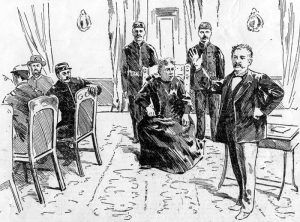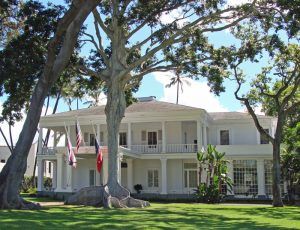Queen Liliuokalani, the last sovereign ruler of Hawaii and the first and only reigning Hawaiian queen, ruled from January 29, 1891, until the overthrow of the Kingdom of Hawaii on January 17, 1893.
Liliuokalani was born as Lydia Kamakaeha on September 2, 1838, in Honolulu, on the island of Oahu, to Analea Keohokalole and Caesar Kapaʻakea. Her family were of Hawaiian nobility and were related to the reigning House of Kamehameha, which had ruled since 1795. As such, she and her siblings were informally adopted by other Hawaiian royals, which was a common practice at the time. She was then raised by Abner Paki and Laura Konia along with their daughter, Bernice Pauahi Bishop.
Lydia was baptized as a Christian and educated at the Royal School, as well as making tours of the Western world when she was young. Early on, she and her siblings and cousins were proclaimed eligible for the throne by King Kamehameha III. After her schooling, she served as a member of the court of King Kamehameha IV.
In September 1862 she married American-born John Owen Dominis, who was the son of a Boston sea captain and an official in the Hawaiian government. Dominis would later become the Governor of Oahu. The couple had no biological children but adopted several others.
In 1874 her brother David Kalakaua was chosen as king and she and her siblings were given Western-style titles of Prince and Princess. In 1877, on the death of a second brother, W.P. Leleiohoku, she was proclaimed as the heir apparent to the throne. At that time, she became known by her royal name, Liliuokalani and took on several royal duties. She served as regent during King Kalakaua’s world tour in 1881, and she was active in organizing schools for Hawaiian youth. During the Golden Jubilee of Queen Victoria in 1887, she represented her brother as an official envoy to the United Kingdom. During the world tour, she was also received by U.S. President Grover Cleveland.
In the meantime, King Kalakaua and Queen Kapiolani moved into the just-finished Iolani Palace in 1882, which served as the official residence of the Hawaiian monarchs as well as the seat of government.
In 1890, the U.S. Congress passed the Tariff Act which ended the favored status of sugar imported from Hawaii, raised import rates, and crippled the Hawaiian sugar industry. Facing economic hardship and potential loss of power, American missionaries, business entrepreneurs, and European and American politicians began to seriously consider the overthrow of the Hawaiian monarchy and annexation of the islands by the United States. If the Hawaiian Islands became a U.S. territory, Hawaiian sugar producers would be provided with the same economic and monetary benefits as those enjoyed by U.S. domestic producers.
In the midst of this crisis, King Kalakaua died in January 1891, and his sister and heir, Liliuokalani, became the ruler of the Hawaiian Kingdom. Upon her succession, Queen Liliuokalani, disturbed by the loss of power of the monarchy under King Kalakaua, tried to restore a more traditional autocracy to the Hawaiian throne. She attempted to draft a new constitution which would restore the power of the monarchy and the voting rights of native Hawaiians.
She had earlier made her position clear by opposing the renewed Reciprocity Treaty of 1887, which granted commercial concessions to the United States and ceded to them the port of Pearl Harbor. At that time, many of her opposers which included U.S. and European entrepreneurs, politicians, and businessmen, were working toward annexation of the Hawaiian Islands to the United States.
The fallout led to citywide political rallies and meetings in Honolulu. One group, called the Committee of Safety, was formed to protest of the “revolutionary” action of the queen and conspired to overthrow her. In response, royalists and loyalists formed the Committee of Law and Order and met at the palace square on January 16, 1893. Led by Robert W. Wilcox, and other pro-monarchist leaders, the group gave speeches in support for the queen and the government. Charles Wilson, the Marshal of the Kingdom, requested warrants to arrest the 13-member council of the Committee of Safety, and put the Kingdom under martial law. However, his request was denied by the queen’s cabinet, who feared that the arrests would escalate the situation.
After a failed negotiation with the Committee of Safety, Charles Wilson and Samuel Nowlein, captain of the Royal Household Guard, gathered a force of 496 men to protect the queen. In response, Marines from the USS Boston and two companies of US sailors landed and took up positions at the US Legation, the Consulate, and Arion Hall. Though they did not enter the palace grounds, take over any buildings, and never fired a shot, their presence effectively intimidated royalist defenders. Those who wanted her to abdicate asked her to step down In January 1893. Backed by the U.S. government and with the aid of the U.S. military, Queen Liliuokalani, to avoid bloodshed, yielded her authority on January 17, 1893. She immediately appealed to President Grover Cleveland to reinstate her, and her request was granted. However, the pro-annexation leader, Sanford B. Dole, had already taken control of Iolani Palace and had made it the executive building for the new government. On January 19, a delegation departed for Washington D.C. to ask for immediate annexation by the United States.
When arms were found hidden at her personal residence, Washington Place, Liliuokalani was arrested and imprisoned in an upstairs bedroom of Iolani Palace. She formally abdicated her throne on January 24, 1895, to win clemency for the rebels who supported her. Later, she would write:
“For myself, I would have chosen death rather than to have signed it; but it was represented to me that by my signing this paper all the persons who had been arrested, all my people now in trouble by reason of their love and loyalty towards me, would be immediately released.”
On February 1, 1895, Hawaii was made a protectorate of the United States to temporarily provide a buffer against domestic upheaval and interference by foreign governments. At that time, the U.S. flag was raised over the palace and martial law was enforced.
Queen Liliuokalani was tried for treason by the military commission of the Hawaii Republic in the palace throne room on February 8th. Though she claimed ignorance, she was sentenced to five years of hard labor in prison by the military tribunal and fined $5,000. On September 4, the sentence was commuted to imprisonment in the palace. In the second floor room of the palace, she was allowed one lady-in-waiting during the day, but no visitors.
On October 13, 1896, the Republic of Hawaii gave her a full pardon and restored her civil rights. She then returned to her home, Washington Place.
Afterward, Liliuokalani fought bitterly against the annexation of the Hawaiin Islands by the United States, but annexation nonetheless occurred in July 1898. The annexation treaty also granted Liliuokalani a $20,000 per annum lifetime pension. That same year, she published the book Hawaii’s Story by Hawaii’s Queen and composed Aloha Oe, a song ever afterward beloved in the islands.
She continued the fight for the return of the Hawaiian Crown Lands and in 1909, brought an unsuccessful lawsuit against the United States under the Fifth Amendment. She then continued to fight for compensation of the seized land, which was again unsuccessful.
Afterward, she returned to Washington Place in Hawaii where she lived out the remainder of her later life as a private citizen. She died of a stroke at her residence in Honolulu on November 11, 1917. She was 79 years old. Her remains are held at the Royal Mausoleum of Hawaii in Honolulu.
Both her former home, Washington Place and Iolani Palace serve as museums today and are National Historic Landmarks.
Hawaii would go on to become the 50th and most recent State, achieving statehood in August of 1959.
©Kathy Weiser-Alexander, February 2019.
Also See:
Iolani Palace, Honolulu, Hawaii
Sources:







